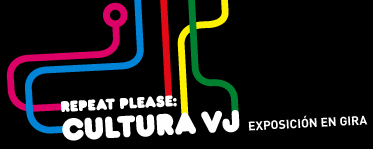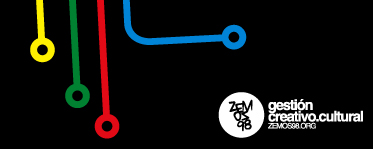English
EUTOPIA07 – EXHIBITION – PRESS RELEASE (pdf)
Repeat Please: VJ culture
EUTOPÍA 07
Cordoba, Spain, September 14 to 22
Teatro Cómico Principal
synopsis…
“Repeat Please: VJ Culture” is an exhibition curated by the ZEMOS98 collective for Eutopia 07. The project is an informative exhibition about the culture of video jockeys, or VJs – creators of the audiovisuals of the present and the future. The term VJ is used to describe artists who create visual sessions by mixing video loops with music in a live context. Artists from around the world will participate in the exhibition, which will also include a demo area allowing hands-on access to VJ software and hardware, videos and interactive audiovisual installations. The finalists of the VJ section of the Youth Creation and Arts Competition will perform at the opening, which will end with a session by Addictive TV.
eutopia 07 is organised by the Andalusian Youth Institute
www.eutopia07.org
a project by…
ZEMOS98 is an international collective for cultural creation and production that has been developing projects from its base in Seville since 1995. It is made up by a team of “communicologists” and “technologists” who work with sound and image and inhabit the Internet as a just another new space for communication, learning and creation. They are responsible for putting together the annual ZEMOS98 Audiovisual festival, which has become an essential event for those wishing to understand contemporary audiovisual culture. Participating projects and artists have included DJ Spooky, Peter Greenaway, Coldcut, Pierre Bastien and Olia Lialina, among many others.
The technical production of “Repeat Please: VJ Culture” will be in the hands of Hapaxmedia.net, who also handle technical and audiovisual production for ZEMOS98. The project image is a fragment of one of the earliest Abe-Paik video synthesizer tests in 1973.
intro.
The art of live video – VJ culture – is experiencing a period of growth in Spain. It is only recently that communities have started to form and specialist hardware and software has begun to appear, specifically designed for today’s audiovisual artists. It’s also symptomatic that the first books dealing exclusively with VJing and its associated culture have been published within the last two years.
We could say that over these last two years, VJing has established itself as a discipline like any other within the contemporary art and performance scene. At festivals, it’s no longer strange to find that the VJs are also acclaimed artists. The main objective of this project is to try and understand the way things stand at the present moment.
EUTOPIA and the Andalusian Youth Institute have taken an important step for the VJ scene in Spain by organising the 1st VJ Competition, the first of its kind, as part of Youth Creation and Arts activities. The specialist VJ portal – www.vjspain.es – points out that,” Once again, the Junta de Andalucia is the only autonomous community government that supports and promotes the VJ phenomenon. When will other parts of Spain join them…?.»
This institutional support makes sense because it is based on the initiative of bodies like the ZEMOS98 audiovisual festival, which has brought some of the world’s most important visual artists to Seville over the last few years. This precedent generated a context that encourages the emergence of other projects such as LUX’06, an important meeting of VJs from around the world held in May 2006, also in Seville with the support of the IAJ and other public institutions. And obviously, we should also mention the importance of pioneer collectives like Visu-all (Seville) and Miga (Granada).
Some of the earliest professional VJ projects made in Spain came out of Andalusia, even though history, the press and culture in general insist on positioning Barcelona and Madrid as the two major centres of Spanish visual creation. In spite of this, we can affirm that Andalusia has been one of the most active nodes on various fronts of a larger culture – the culture of software, events, artists and funding….
This exhibition + publication is an in-depth exploration of some of the pioneering works and artists from around the world. But even more importantly, it aims to answer some basic questions: what is a VJ? what is a Loop? and what about remix? and above all, to offer a multi-channel journey through contemporary visual culture.
outlines of VJ culture
A whole history exists, a history that is scarcely written and joins many other forms of visual culture from the 20th and 21st centuries. VJ culture has always approached audiovisuals from the experimental point of view, but it has also been in close contact with technological development, which has been vertiginous and overwhelming in the case of video.
To mention some influences that can allow us to sketch an outline of «VJ culture» and its history, our first important reference is experimental and “artistic» cinema. We’d also mention the «Letterist International» movement in 1960s France, which proposed going “beyond the screen”, where the “audiovisual spectacle” of cinema would come into play with the audience and where the audio and image tracks would be completely dissociated. Other notable influences from the 80s, also in the field of cinema, were Zbigniew Rybczynski’s Stop Motion works. In the Andalusian context, an essential reference is José Val del Omar, the «cinemaist» from Granada who was a tireless experimenter in image and sound.
Another important influence is the history of experimental video, which dates back to 1963 and pioneers like the Korean-born US artist Nam June Paik and the Spanish-German artist Wolf Vostell. From a historical perspective, and now that Spanish audiences have had the chance to visit major exhibitions of his work, any of Paik’s works could become an endless source of resources for VJs, because in the end his work is a remixing and kneading together of visual culture, television, transgression and exacerbated theatricality.
It is also important to mention the influences of other contemporary cultures, in this case DJs and the importance of electronic music and dance culture. The DJ as a true master of ceremonies and channeller of trends and styles. Raves, parties and the club culture have make up the context in which some VJs work professionally today. Hence the touch of mysticism and the constant references to synaesthetic, hedonistic and cyborg imagery in many visual works in this field.
It’s clear that IT systems and digital editing have made it possible to create videos on almost any computer, and the quality of home video cameras and even mobile phone cameras is improving by the day. Internet, as a channel for communication and learning is another essential element in developing the world of VJs.
On the other hand, television has also been an important source of inspiration. Some of the tools that VJs use today are a result of the television technology market, given that mixing desks, field monitors and mini-cameras exist because television continues to grow and diversify in market terms. Video clips are totally collateral and a sister discipline – more than a few VJs make video clips, while just as many VJs use video clips as a source for their work.
And television itself is also a huge open archive. While not everyone agrees, it’s common practice for VJs to re-use television in their own work. We can’t ignore that TVs emit video and audio signals 24 hours a day on an endless number of channels and programs. Television is the source of philias and phobias and of many forms of art dealing with the contemporary world, and so one of the themes we want to sketch out in this project is the line drawn between experimental video, mass culture as represented on television, and the VJ phenomenon. We warn that it won’t be a uniform or objective line. In this sense, «The VJ Book» quotes David Pescovitz saying “the revolution will not be televised, but it is starting to be projected”.
There is one other element that can’t be left out. We’re talking about the aesthetics of reappropriation, plagiarism as art, the remix. In a way, art and visual representation are an ongoing attempt to “copy” the artist’s vision of the real, and when photography and cinema appeared the copies were “perfect» and went on to become part of the real.
VJs, or any artist who takes on the precepts of contemporaneity as proposed by Marcel Duchamp and his «ready-mades”, uses the material at hand as a source of inspiration. The copying, manipulation and representation of the real includes images from films, DVDs, video clips and video games. In an interview by the collective ZEMOS98 about his remix of D.W. Griffith’s “The Birth of a Nation», the musician and philosopher DJ Spooky said, «The profile of the DJ is already established in our minds, which is why the art of the 20th Century has become the inspiration for the art of the 21st century.»
artists
This exhibition has a strong focus on information, but it will also include works by some of the most important VJ artists, both pioneers and outstanding artists working today. This means there will be many different kinds of VJs, visual and audiovisual artists, those whose work is based on software rather than hardware and artists who work with synthesised images rather than those who only work with «real» images.
Collectives and individual artists will also be joining us from Spain, Europe and the rest of the world. The importance of communities will be emphasised, and the publications and festivals that support and generate the VJ phenomenon will also be represented.
Artist 100% confirmed:
Nam June Paik, COLDCUT & HEXSTATIC, Benton-C Bainbridge, Nika Offenbac & Devan Simunovich – C-TRL Labs , Ryoichi Kurokawa, LIA & @c, Eclectic Method, DELACREW (Rez, Juan Jose Ortiz, Bruno Farinós), The Light Surgeons, Addictive TV, D-FUSE, Olga Mink, NoTV, Le Projecionniste (Stéphane Abboud), Zelabo (Jerome Hutain & Celine Parent), Rechenzentrum, Dienststelle, timo novotny, Delaware, Ben Sheppee, VJ Culture, LoVid (Tali Hinkis and Kyle Lapidus), C505, scott pagano, Vj V2 – Vello Virkhaus, vadim epstein [vj eps], 2/5 BZ – Serhat Köksal, Pitch Black, VJzoo (Kat Black & Jasper Cook), Arturo Gil, Astronauta Mecánico, ZIBE ideas animadas (Gustavo Zibecchi – Martin Vazquez – Eliseo Acierno), Óscar Testón, //[o_Ó]< < – Pablo Sanz, Fuss!, Juanjo Fernández, SOLU, Eloi Maduell, txampa, Actop, Juan Rayos, LA COMIDA visuals, Fundación Intemperie (Roi Fernández & Isaac Cordal), fiumfoto, K vj, Miga vj´s team (Nökeo + Decolora), voluble.net, Kowalski, colectivo ZEMOS98.org.
An exhibition catalogue will be published with specialised texts on the different areas of the exhibition and images of the works included in it. This catalogue will be the first of its kind published in Spain, and to contribute to the social expansion of the concepts it covers, it will also be available in PDF format.
The exhibition and final configuration will be designed exclusively for the Teatro Cómico Principal de Cordoba, and organised into four exhibition areas:
1/ Single-channel videos, showing the essential videos that have influenced VJ aesthetics and bringing together as many international references and styles as possible.
2/ Interactive audiovisual installations
3/ Demo Zone, where visitors can touch and manipulate some of the professional hardware and software used in VJ culture.
4/ Reference Zone, where visitors can watch audiovisual archives of VJ festivals, and consult books and other reference materials to broaden VJ culture.
opening
The exhibition has been organised as part of Eutopia 07, in line with its interest in the most innovative and daring contemporary arts. In keeping with this, the exhibition opening will include a double program of audiovisual sessions:
1/ The final stage of the VJ section of the Youth Creation and Arts competition. With performances by the 5 finalists from Andalusia.
2/ Audiovisual Concert by ADDICTIVE TV.
english texts
– VJ Culture: From Loop Industry To Real Time Scenarios by Mia Makela



